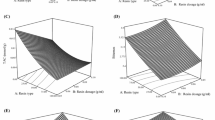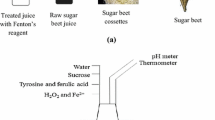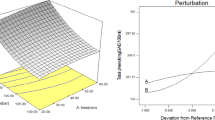Abstract
Reconstituted grapefruit juice was debittered with XAD-7HP adsorbent resin in batch experiments and the adsorption rate constants of the bitter principal naringin and the volatile flavor compounds α-pinene, β-myrcene, dlimonene, α-terpineol, and β-caryophyllene were determined using a pseudo-first order kinetic model. The highest rate constants were observed consistently for the off-flavor α-terpineol, followed by naringin and the other flavor compounds. The rate constant of each substance was influenced significantly by temperature, ratio of adsorbent/juice, and, except for α-terpineol, by the interaction of both factors (p<0.05). Response surface methodology (RSM) was applied for the development of regression models to predict the adsorption rate constants of all substances. On the basis of the regression models for d-limonene and naringin, a factor combination that minimized loss of flavor and maximized bitterness reduction during the debittering procedure was determined to be a combination of low temperature (13.9°C) and high adsorbent/juice ratio (3.6%).
Similar content being viewed by others
References
Carabasa M, Ibarz A, Garza S, Barbosa-Canovas GV. Removal of dark compounds from clarified fruit juices by adsorption processes. J. Food Eng. 37: 25–41 (1998)
Leggott NL, Shephard GS, Stockenstrom S, Staal E, van Schalkwyk DJ. The reduction of patulin in apple juice by three different types of activated carbon. Food Addit. Contam. 18: 825–829 (2001)
Johnson RL, Chandler BV. Reduction of bitterness and acidity in grapefruit juice by adsorptive processes. J. Sci. Food Agr. 33: 287–293 (1982)
Johnson RL, Chandler BV. Ion exchange and adsorbent resins for removal of acids and bitter principles from citrus juices. J. Sci. Food Agr. 36: 480–484 (1985)
Chandler BV, Johnson RL. Contacting citrus juice with a cellulose ester adsorbent to remove limonin. U.S. Patent 3,989,854 (1976)
Shaw PE, Baines L, Milnes BA, Agmon G. Commercial debittering processes to upgrade quality of citrus juice products. pp. 120–131. In: Citrus Limonoids: Functional Chemicals in Agriculture and Foods. Berhow MA, Hasegawa S, Manners GD (eds). ACS Symposium Series 758. American Chemical Society, Washington, DC, USA (2000)
Fayoux SC, Hernandez RJ, Holland RV. The debittering of navel orange juice using polymeric films. J. Food Sci. 72: E143–E154 (2007)
Kimball DA, Norman SI. Changes in california naval orange juice during commercial debittering. J. Food Sci. 55: 273–274 (1990)
Kimball DA, Norman SI. Processing effects during commercial debittering of california navel orange juice. J. Agr. Food Chem. 38: 1396–1400 (1990)
Hui YH. Orange Juice Processing. pp. 361–390. In: Food Processing: Principles and Applications. Smith JS, Hui YH (eds). Blackwell Publishing Professional, Ames, IA, USA (2004)
US Government. Grapefruit Juice. Code of Federal Regulations Title 21 146. 132 (1981)
Sakano T, Yamamura K, Tamon H, Miyahara M, Okazaki M. Improvement of coffee aroma by removal of pungent volatiles using A-type zeolite. J. Food Sci. 61: 473–476 (1996)
Lucas S, Cocero MJ. Improvement of soluble coffee aroma using an integrated process of supercritical CO2 extraction with selective removal of the pungent volatiles by adsorption on activated carbon. Braz. J. Chem. Eng. 23: 197–203 (2006)
Weinand R. Apple juice stabilization and decolouring by modern adsorption techniques. Flussiges Obst. 63: 495–498 (1996)
Ma SX, Lada MW. Quality fruit juice beverages having extended quality shelf-life and methods of making the same. U.S. Patent 6,534,107 (2003)
Di Cesare LF, Nani R, Bertolo G, Polesello A. Anwendung apolarer sorptionsmittel für die gewinnung von fruchtsaftaroma. teil 2: versuche mit golden delicious apfelsaft (Utilization of apolar sorption devices for the recovery of fruit juice aroma. Part 2: Experiments with golden delicious apple juice). Flussiges Obst. 54: 206–210 (1987)
Ericson AP, Matthews RF, Teixeira AA, Moye HA. Recovery of grapefruit oil constituents from processing waste-water using styrene-divinylbenzene resins. J. Food Sci. 57: 186–189 (1992)
Shen Z, Mishra V, Imison B, Palmer M, Fairclough R. Use of adsorbent and supercritical carbon dioxide to concentrate flavor compounds from orange oil. J. Agr. Food Chem. 50: 154–160 (2002)
Subra P, Vega-Bancel A, Reverchon E. Breakthrough curves and adsorption isotherms of terpene mixtures in supercritical carbon dioxide. J. Supercrit. Fluid. 12: 43–57 (1998)
Tseng DJ, Matthews RF, Gregory JF, Wei CI, Littell RC. Sorption of ethyl butyrate and octanal constituents of orange essence by polymeric adsorbents. J. Food Sci. 58: 801–804 (1993)
Bitteur S, Rosset R. Use of an octadecyl-bonded silica and a styrene-divinylbenzene copolymer for the recovery of blackcurrant aroma compounds from a food plant waste-water. J. Food Sci. 53: 141–147 (1988)
Edris AE, Girgis BS, Fadel HHM. Recovery of volatile aroma components from aqueous waste streams using an activated carbon column. Food Chem. 82: 195–202 (2003)
Ribeiro MHL, Silveira D, Ferreira-Dias S. Selective adsorption of limonin and naringin from orange juice to natural and synthetic adsorbents. Eur. Food Res. Technol. 215: 462–471 (2002)
Shaw PE, Rouseff RL, Goodner KL, Bazemore R, Nordby HE, Widmer WW. Comparison of headspace gc and electronic sensor techniques for classification of processed orange juices. Lebensm. - Wiss. Technol. 33: 331–334 (2000)
Sheung KSM, Min S, Sastry SK. Dynamic head space analyses of orange juice flavor compounds and their absorption into packaging materials. J. Food Sci. 69: C549–C556 (2004)
Lagergren S. Zur theorie der sogenannten adsorption gelöster stoffe (About the theory of the so-called adsorption of soluble substances). K. Sven. Vetenskapsakad. Handl. 24: 1–39 (1889)
Lin J, Wang L. Comparison between linear and non-linear forms of pseudo-first-order and pseudo-second-order adsorption kinetic models for the removal of methylene blue by activated carbon. Front. Env. Sci. Eng. China 3: 320–324 (2009)
Jain AK, Gupta VK, Bhatnagar A, Suhas. Utilization of industrial waste products as adsorbents for the removal of dyes. J. Hazard. Mater. 101: 31–42 (2003)
Derringer G, Suich R. Simultaneous optimization of several response variables. J. Qual. Technol. 12: 214–219 (1980)
Kranz P, Adler P, Kunz B. Sorption of citrus flavour compounds on XAD-7HP resin during the debittering of grapefruit juice. Int. J. Food Sci. Tech. 46: 30–36 (2011)
Halek GW, Meyers MA. Comparative sorption of citrus flavor compounds by low density polyethylene. Packag. Technol. Sci. 2: 141–146 (1989)
Scordino M, Di Mauro A, Passerini A, Maccarone E. Adsorption of flavonoids on resins: Hesperidin. J. Agr. Food Chem. 51: 6998–7004 (2003)
Scordino M, Di Mauro A, Passerini A, Maccarone E. Adsorption of flavonoids on resins: Cyanidin 3-glucoside. J. Agr. Food Chem. 52: 1965–1972 (2004)
Kammerer DR, Saleh ZS, Carle R, Stanley RA. Adsorptive recovery of phenolic compounds from apple juice. Eur. Food Res. Technol. 224: 605–613 (2007)
Collado IG, Hanson JR, Macias-Sanchez AJ. Recent advances in the chemistry of caryophyllene. Nat. Prod. Rep. 15: 187–204 (1998)
Author information
Authors and Affiliations
Corresponding author
Rights and permissions
About this article
Cite this article
Kranz, P., Adler, P. & Kunz, B. Investigation of citrus flavor adsorption during debittering of grapefruit juice using kinetic modeling and response surface methodology. Food Sci Biotechnol 20, 715–724 (2011). https://doi.org/10.1007/s10068-011-0101-y
Received:
Revised:
Accepted:
Published:
Issue Date:
DOI: https://doi.org/10.1007/s10068-011-0101-y




